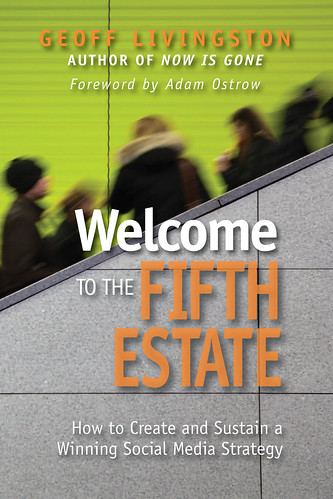 Think about when Twitter became a household name. Do you remember when that was?
Think about when Twitter became a household name. Do you remember when that was?
I do.
It was when the plane went down in the Hudson River and a guy named Janis Krums tweeted a photo of the plane in the river, from the ferry (about as close as anyone could get without being on the plane), as they were going to rescue the passengers.
That was January 2009…and that was the turning point.
Krums tweeted the photo and the “news” instantly. And it took traditional media, what seemed, an eternity to report on the crash. In this instance, Krums represented citizen journalists, or the Fifth Estate, and Twitter became a household name.
Welcome to the Fifth Estate
Geoff Livingston, co-owner at Zoetica, and now two-time author (not including the two books he hasn’t published) is the author of the newly released Welcome to the Fifth Estate.
The Fourth Estate, or the traditional media, got its nickname by policing the governments of France and Great Britain in the late 18th and early 19th centuries.
The French Estates General consisted of The First Estate of 300 clergy, the Second Estate of 300 nobles, and the Third Estate of 600 commoners.
The media, or the Fourth Estate, fulfilled a new role, providing their readership with more factual information about political events. As a result, politicians were held to a new level of accountability.
The Fifth Estate, or citizen media, often introduces previously unreported, yet relevant news, and it questions stated facts.
Think back when Natasha Richardson died. The Fifth Estate reported her death, not minutes, not hours, but days before it was confirmed. People at the ski resort where she fell and hit her head witnessed…and reported.
Case Studies, Measurement, Actions…Oh My!
The book follows the idea of the Fifth Estate, as it relates to marketing and to how companies can and should communicate with their citizen journalists.
It has 14 case studies that follow a summary, engagement, results outline. It’s worth the read just for those as they’re not commonly used case studies and there is a variety for several industries, including non-profits and associations.
The chapter on measurement, written by Geoff’s business partner Kami Watson Huyse, is one of the best I’ve read. She understands how to relate the Fifth Estate activities to a P&L and gives you tips to create your own dashboard that will make the executive team happy and you an investment instead of an expense.
You’ll recognize some well-known names in the book, and you’ll also find some friends (cough, Ike Pigott and Shonali Burke, cough).
But if you buy it for only one reason, it’s for the list of general actions to consider as you embark on integrating new tools into your marketing program (hint, it begins on page 113).
So there you have it. I highly recommend it. It’s one of the best business books I’ve read since Groundswell. You can buy it by clicking here (not an affiliate link because we’re not allowed in Illinois).
Disclosure: Geoff is a friend. He gave me a copy of his book (though I’m going to buy copies for our clients) and he signed it for me. He bought me a glass of wine and this really yummy fig and marscapone bruschetta in NYC last week, while we discussed some future projects. But I’d already read the book and written most of the review at that point. So I wouldn’t really consider it a bribe.